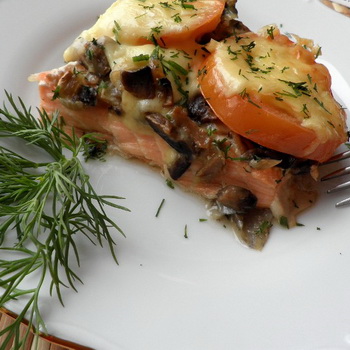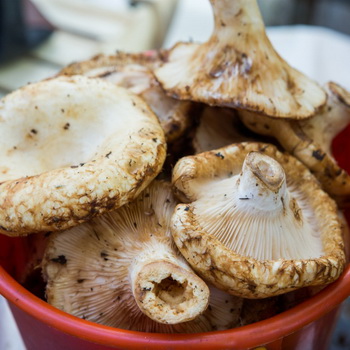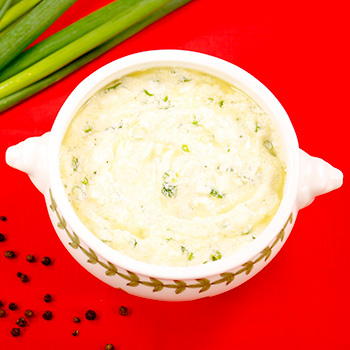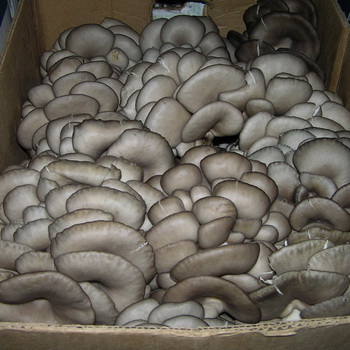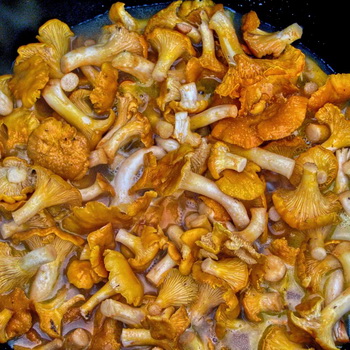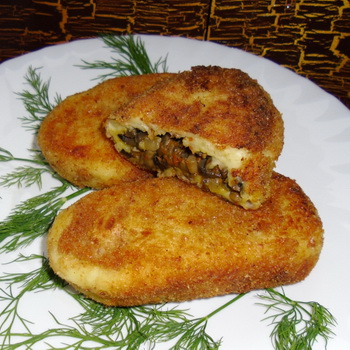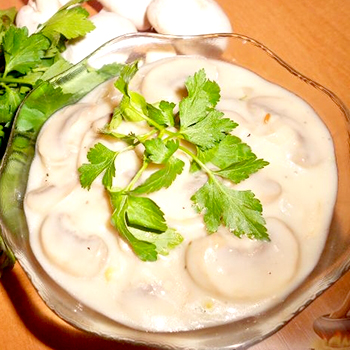What are the varieties of oyster mushrooms: photo, description of appearance, useful properties for the human body
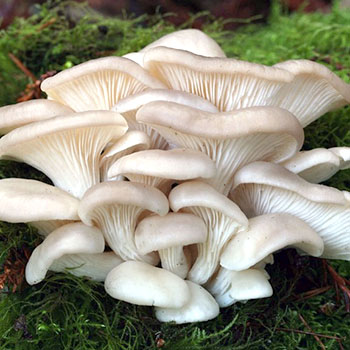 The most common types of oyster mushrooms are common, elm, covered, pulmonary and autumn. All these forms have unique properties, therefore they are widely used in the culinary and pharmaceutical industries. Considering the benefits of oyster mushrooms, they are actively used to prepare a variety of dishes; they are used to prepare remedies according to traditional medicine recipes for healing wounds and removing toxins.
The most common types of oyster mushrooms are common, elm, covered, pulmonary and autumn. All these forms have unique properties, therefore they are widely used in the culinary and pharmaceutical industries. Considering the benefits of oyster mushrooms, they are actively used to prepare a variety of dishes; they are used to prepare remedies according to traditional medicine recipes for healing wounds and removing toxins.
In winter, these mushrooms tend to freeze and become hard. Moreover, it is easy to beat them off with a stick. The quality of winter oyster mushrooms depends on the stage in which the mushrooms were at a sharp drop in temperature. If the frosts were early, then they can freeze when young. In the event of several winter thaws, these mushrooms may disappear. Useful qualities are preserved in winter.
You will learn about what oyster mushrooms look like and what properties they have on this page.
Description of common oyster mushroom

The cap of the common oyster mushroom (Pleurotus ostreatus) has a diameter of 4-12 cm. A distinctive feature of the species is the oyster, oval or round shape of the cap of a gray-brown, creamy brown color with a darker central part. The bases of the fruit bodies are fused.
This type of oyster mushroom has a short leg, asymmetrically located, most often on the side of the cap, it is 2-7 cm high and 10-25 mm thick. The leg is the same color as the cap and is located on the side of the cap.
Pulp: thin, dense, white, with a pleasant taste and smell.

The plates are adherent, descending along the pedicle, frequent, cream or light yellow in color.
Variability. The color of the cap varies from brown to brownish gray.
Similar species. In appearance, oyster mushroom is similar to pulmonary oyster mushroom (Pleurotus pulmonarius), which is creamy in color and has an ear-shaped cap.
The property of accumulating harmful substances: this species has the positive property of low accumulation of heavy metals.
Edibility: common oyster mushrooms have high nutritional properties, can be boiled and fried, canned.
Edible, the 2nd and 3rd categories - in the autumn and the 3rd and 4th categories - in the winter.
Oyster mushrooms in late November and early December still have a normal appearance. At the end of winter and early spring, they change, acquire a yellow-brown color.
Habitat: deciduous and mixed forests, on decaying deciduous wood, grow in tiers and groups.

Season: intensive growth - from May to September, and starting from November and in winter the growth stops. In winter, the state of oyster mushrooms on trees depends on the stage at which frost found them and what climate preceded the onset of freezing temperatures. If by the onset of frost the vesicles have reached their maximum growth and are slightly dry, then in winter they dry out a little more and hang on trees in frost in a semi-solid state, when they can be cut off.
If by the time of the frost the weather was wet, the mushrooms freeze and become hard, "glassy". In this state, it is impossible to cut them off the trunk, but you can beat them off with a stick or pinch them off by prying them off with a knife. Do not use an ax to avoid damage to trees.
Here you can see a photo of an oyster mushroom, the description of which is given above:



What does elm oyster mushroom look like (with photo)

Elm lyophyllum, or elm oyster mushroom (Lyophyllum ulmarium) is extremely rare in winter. In fact, they are edible in the same way as common oyster mushrooms, but difficult to access due to their high location on tree trunks.
In winter, they most often remain on the bends of oak trees, often at a height of more than one and a half meters. Their external state depends on the moment at which frost caught them.If by the onset of freezing temperatures the weather was not wet, and oyster mushrooms reached their maximum growth, then they will remain so throughout the winter. In a thaw, they can wither, their edges can become even more wavy and individual mushrooms from light brown become brown-black and completely wither.

These mushrooms should be collected at the beginning of winter or until the end of winter, but not allowed to thaw, when they can wilt, fall off like old leaves.
These mushrooms are the largest edible winter mushrooms, with an average cap diameter of 10-20 cm.
Habitat: deciduous forests, parks, on stumps and trunks of oak, elm, elm and other deciduous trees, singly or in small groups.
The hat has a diameter of 5-15 cm, sometimes up to 20 cm, first convex, later extended.
As you can see in the photo, a distinctive feature of this type of oyster mushroom is an unusually beautiful color of the cap, like that of a sunflower - sunny, yellowish-brown, the surface of the cap is leathery, finely rough with water spots:



By winter, the surface of the cap becomes yellow-straw and the spots are no longer noticeable. When the mushroom grows on a tree, less often on a stump, it may have an asymmetrical leg arrangement. The edges of the cap are bent downwards, they are wavy. The color at the edges is slightly lighter than in the main part of the cap. In winter, the color changes to straw yellow. Older specimens darken, become black-brown or brown-brown.
The stem is 4-10 cm long, 7-15 mm thick, at first whitish-cream, later yellowish and light brown. The bases of the legs are often fused.
The pulp is soft, gray-lilac, with a mild taste, almost odorless.
The plates are wide, adherent, at first white, later buffy and light brown.

Variability: the color of the cap varies from yellow-golden to dark brown.
Similar species. In autumn, due to its large size and sunny color and watery spots, elm lyophyllum is difficult to confuse with other species. In autumn, this mushroom can be confused in appearance with a crowded row, which differs mainly in its habitat - on the ground, but not in trees. In winter, it does not have similar species.
Cooking methods: boil, fry, salt after preliminary boiling for 15-20 minutes.
Edible, 4th category.
See what the elm oyster mushroom looks like in these photos:



Autumn oyster mushroom: photo and description

Habitats of autumn oyster mushroom (Pleurotus salignus): poplar, linden; grow in groups.
Season: autumn oyster mushrooms grow in September - November until the first snows, and then they freeze until spring, in the absence of thaws in winter they are well preserved in spring.
The hat of this species of oyster mushrooms has a diameter of 4-8 cm, sometimes up to 12 cm. A distinctive feature of the species is the ear-like shape of the hat, gray-brown in color with a velvety, and later leathery surface. All fruiting bodies grow from one base.

The stem is short, asymmetrically located, most often on the side of the cap, it has 2-5 cm in height and 10-40 mm in thickness, pubescent. The color of the leg is cream or white-yellowish.
Pulp: thin, dense, white, with a pleasant taste and smell.
As shown in the photo, the plates of this species of oyster mushrooms are adherent, descending along the leg, frequent, cream or light yellow in color:



Variability. The color of the cap varies from gray-brown to dark brown.
Similar species. Autumn oyster mushroom is similar in shape to oyster mushroom (Pleurotus ostreatus), but has a much darker color with a predominance of dark brown.
Cooking methods: mushrooms can be boiled and fried, canned.

Edible, 4th category.
Next, you will find out what other varieties of oyster mushrooms are.
What does coated oyster mushroom look like?

Habitats of covered oyster mushroom (Pleurotus calyptratus): decaying deciduous wood - birch, aspen, oak, less often - on stumps and dying coniferous wood - spruce and fir, grow in groups.
Season: April - September.
The hat of this species of oyster mushrooms has a diameter of 4-10 cm, sometimes up to 12 cm.A distinctive feature of the species is a tongue-shaped, or ear-shaped cap, covered with a layer of scales, as a result of which the surface has a felt character, at first a grayish-cream color, and later gray-brown with radial fibers.
Pay attention to the photo - the leg of this species of oyster mushrooms is either very short, asymmetrically located, or it is not at all:



Pulp: thin, dense, white, with a pleasant taste and smell.
The plates are frequent, at first white, frequent, later cream or light yellow.

Variability. The cap color ranges from cream to light brown and gray.
Similar species. The covered oyster mushroom is similar in shape to the oyster mushroom (Pleurotus pulmonarius), which is distinguished by a brown cap and the presence of a leg.

Cooking methods: mushrooms can be boiled, fried, preserved.
Description of pulmonary oyster mushroom

Habitats of the pulmonary oyster mushroom (Pleurotus pulmonarius): decaying deciduous wood - birch, aspen, oak, less often - on stumps and dying coniferous wood - spruce and fir, grow in groups.
Season: April - September
The hat has a diameter of 4-10 cm, sometimes up to 16 cm. A distinctive feature of the species is a lingual, ear-shaped or fan-shaped yellowish-white cap, as well as a leg located on the side of the cap. The edges of the cap are thin and often have cracks. The color of the middle part of the cap is often brown, and the edges, on the contrary, are lighter, yellowish.
As you can see in the photo, the edges of the cap of this type of oyster mushroom are fibrous and have a radial outline:



The leg is short, asymmetrically located, most often on the side of the cap, it is 1-3 cm high and 6-15 mm thick. The leg has a cylindrical shape, white, solid, pubescent.
Pulp: thin, dense, white, with a pleasant taste and smell.
The plates are adherent, descending along the pedicle, at first white, frequent, later cream or light yellow.

Variability. The color of the cap ranges from white and yellowish white to cream and tan.
Similar species. Oyster mushroom is similar to oyster mushroom (Pleurotus ostreatus), which is distinguished by a bluish-gray cap in young specimens and gray-blue in mature mushrooms.
The property of accumulating harmful substances: this species has the positive property of low accumulation of heavy metals.

Cooking methods: canning.
Cooking methods: boil and fry, canning.
Edible, 3rd category
These photos show different types of oyster mushrooms, the description of which is presented on this page:



Why are oyster mushrooms useful?
Oyster mushrooms have unique properties - a unique pantry with a set of mineral salts and other essential substances necessary for a person.

They contain a complex of vitamins: A, C, D, E, B1, B2, B6, B12, as well as 18 amino acids necessary for humans.
Also, the beneficial properties of oyster mushrooms are due to the high content of amylase and lipase enzymes, which promote the breakdown of fats, fiber and glycogen.

They contain both irreplaceable unsaturated ester acids and a number of biologically active substances that help reduce cholesterol and have an anti-sclerotic effect.
Oyster mushrooms are very useful for the human body, as they are an excellent effective remedy for the treatment of stomach diseases. To do this, take freshly squeezed mushroom juice on an empty stomach. In this case, gastritis and ulcers can be cured. The useful properties of oyster mushrooms also include the following:
- they improve intestinal motility;
- used to heal wounds and treat ulcers;
- have hemostatic, emollient and enveloping properties;
- promote the removal of toxins, poisons, toxins;
- are a sorbent;
- are an important component of an anti-cholesterol diet, help to lower blood fats, which is very important for the heart vessels and blood circulation;
- oyster mushroom infusion is used for neuroses, for this, finely chopped fresh mushrooms in the amount of 3 tablespoons are poured with half a liter of red wine, for example, Cahors, and insisted for a week, the resulting infusion is drunk in 2 tablespoons before bedtime;
- contain compounds with antioxidant activity, as a result, the aging process of the body is reduced; contain substances that promote the elimination of cholesterol from the body and reduce the risk of atherosclerosis;
- the inclusion of oyster mushrooms in the diet significantly reduces the likelihood of cancer;
- hold promise in the treatment of tropical malaria.
- The benefit of oyster mushrooms for humans is also that they have high antibacterial activity.


